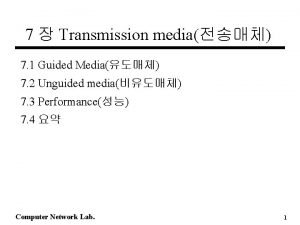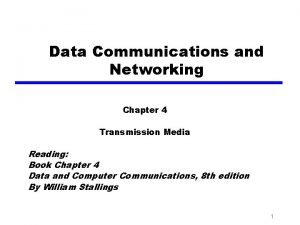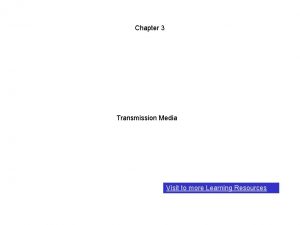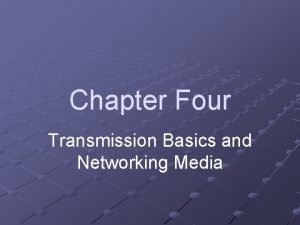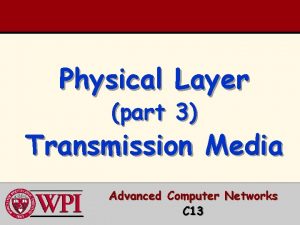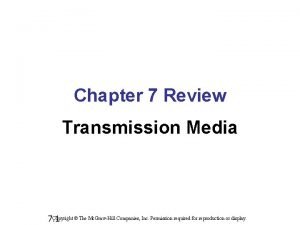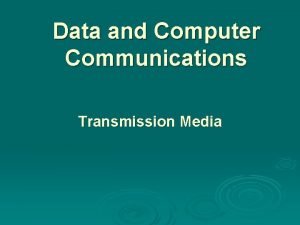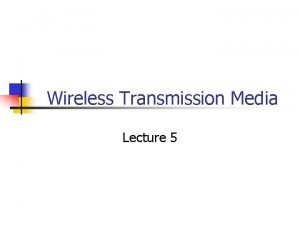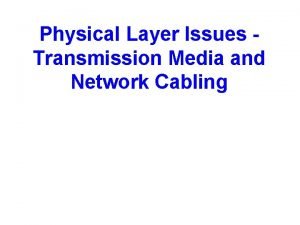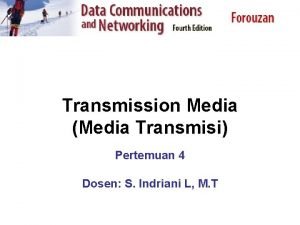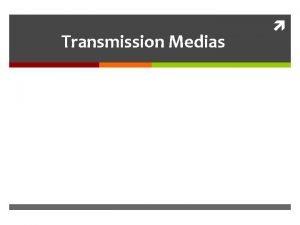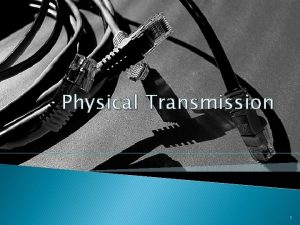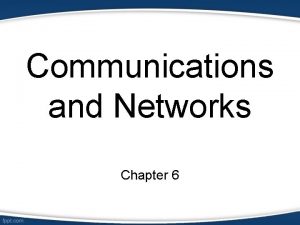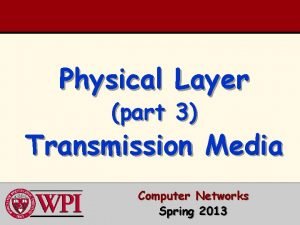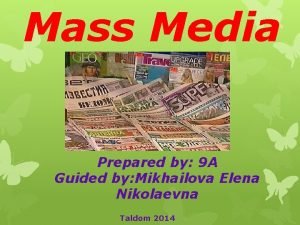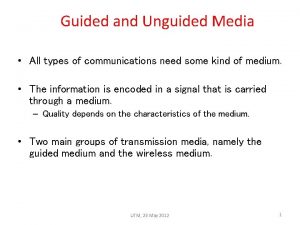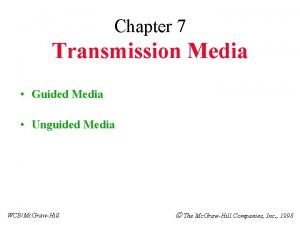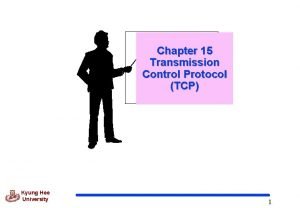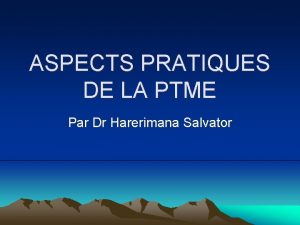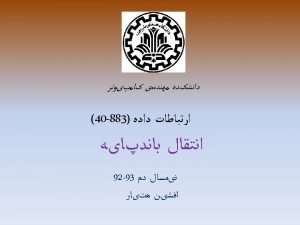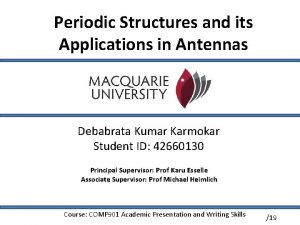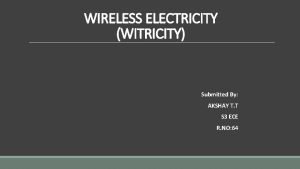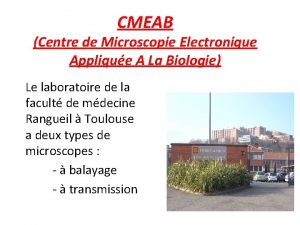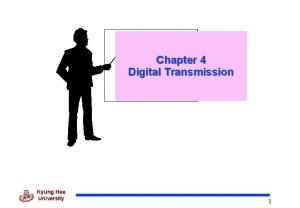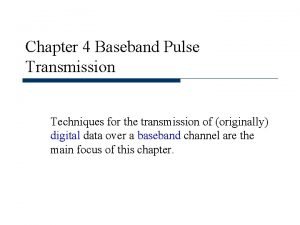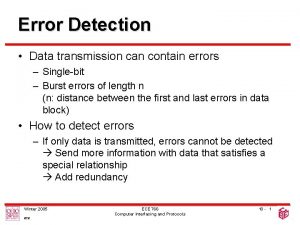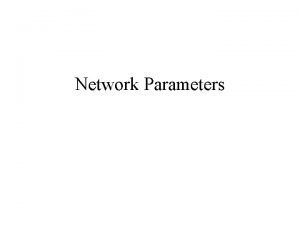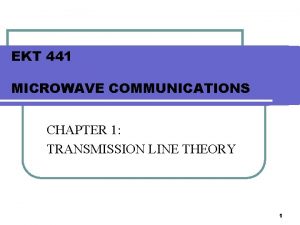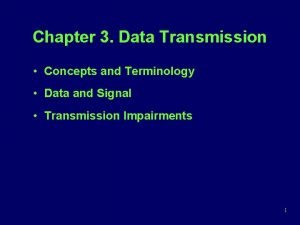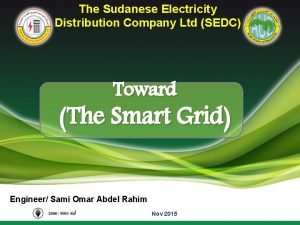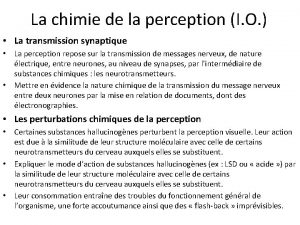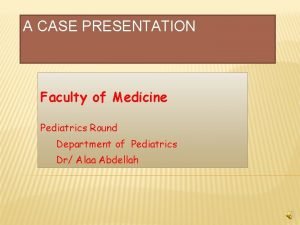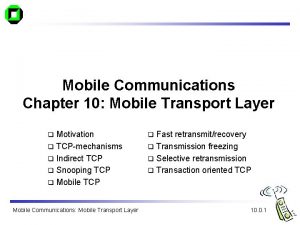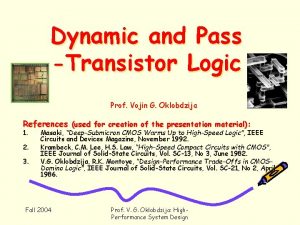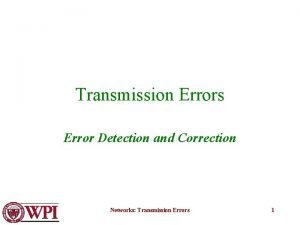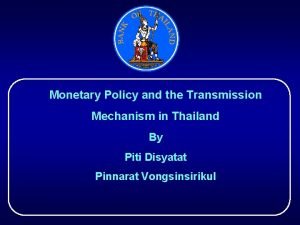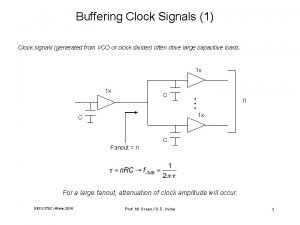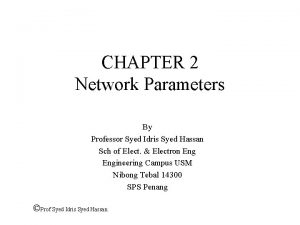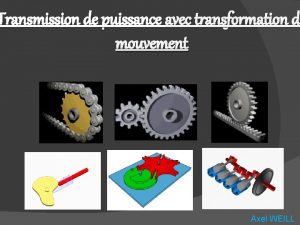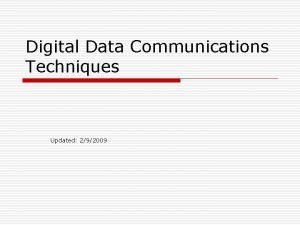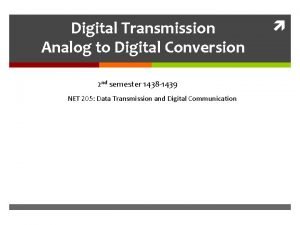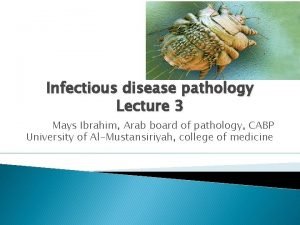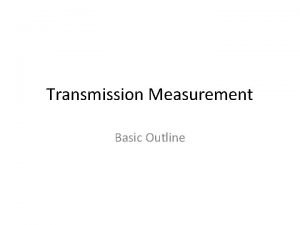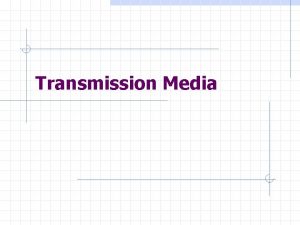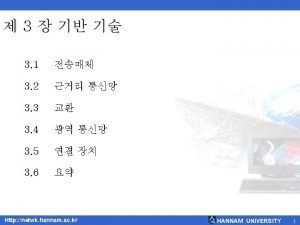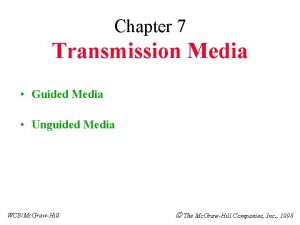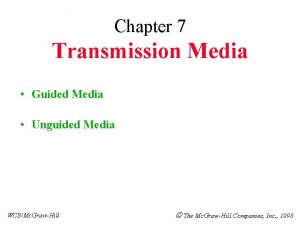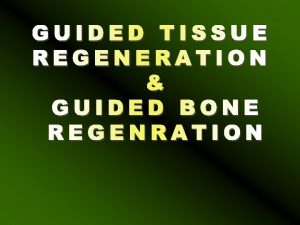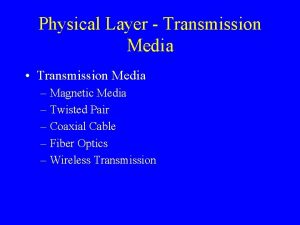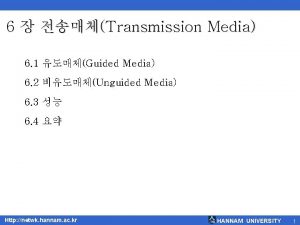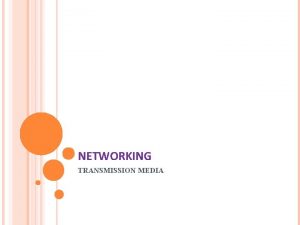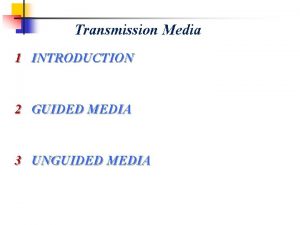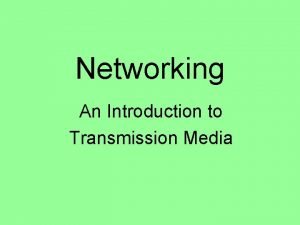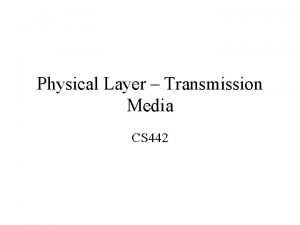7 Transmission media 7 1 Guided Media 7

























































- Slides: 57

7 장 Transmission media(전송매체) 7. 1 Guided Media(유도매체) 7. 2 Unguided media(비유도매체) 7. 3 Performance(성능) 7. 4 요약 Computer Network Lab. 1

전송매체(cont’d) ~ Can be divided into two broad categories : 유도매체, 비유도매체 n Classes of transmission media Computer Network Lab. 2

7. 1 Guided Media(유도매체) n Categories of guided media Computer Network Lab. 3

유도매체(cont’d) n Twisted-Pair Cable ~ comes in two forms : unshielded(비차폐) and shielded(차 폐) n UDP(Unshielded Twisted-Pair) Cable ~ is the most common type of telecommunication medium in use today. n Frequency range for twisted-pair cable Computer Network Lab. 4

유도매체(cont’d) n Twisted-Pair Cable ~ consists of two conductors (usually copper), each with its own colored plastic insulation. Computer Network Lab. 5

유도매체(cont’d) n Effect of noise on parallel lines Computer Network Lab. 6

유도매체(cont’d) n Effect of noise on twisted-pair lines Computer Network Lab. 7

유도매체(cont’d) n Advantage of UTP ~ is cheap, flexible, and easy to install. n Cable with 5 unshielded twisted pairs of wires Computer Network Lab. 8

유도매체(cont’d) n UDP standards has developed to grade by quality l Category 1 : basic twisted-pair cabling (telephone systems) l Category 2 : suitable for voice and for digital data transmission of up to 4 Mbps l Category 3 : ~ used for data transmission of up to 10 Mbps(now standard cable) l Category 4 : possible transmission rate to 16 Mbps l Category 5 : ~ used for data transmission up to 100 Mbps Computer Network Lab. 9

유도매체(cont’d) n UTP connectors ~ a type of snap-in plus like that used with telephone jacks. Computer Network Lab. 10

유도매체(cont’d) n STP(Shielded Twisted-Pair) cable ~ has the same quality consideration as UTP (more expensive, less susceptible to noise) Computer Network Lab. 11

유도매체(cont’d) n 동축 케이블(Coaxial Cable) ~ carries signals of higher frequency ranges n Frequency range of coaxial cable Computer Network Lab. 12

유도매체(cont’d) n Coaxial cable Computer Network Lab. 13

유도매체(cont’d) n Coaxial Cable Standards ~ are categorized by RG(radio government) l RG-8 (used in Thick Ethernet) l RG-9 (used in Thick Ethernet) l RG-11 (used in Thick Ethernet) l RG-58 (used in Thin Ethernet) l RG-75 (used for TV) Computer Network Lab. 14

유도매체(cont’d) n Optical Fiber(광섬유) ~ is made of glass or plastic and transmits signals in the form of light n Nature of Light ~ is a form of electromagnetic energy. It travels at its fastest in a vacuum : 300, 000 km/s. This speed decreases as the medium through which the light travels become denser. Computer Network Lab. 15

유도매체(cont’d) n 굴절(Refraction) * Fiber-optic technology takes advantage of the properties shown in Figure 7. 13 b to control the propagation of light through the fiber channel. Computer Network Lab. 16

유도매체(cont’d) n 임계각(critical angle) l As the angle of incidence(입사각) increase, it moves away from vertical and closer to the horizontal. Computer Network Lab. 17

유도매체(cont’d) n 반사(Reflection) l When the angle of incidence becomes greater than the critical angle, a new phenomenon occurs called reflection Computer Network Lab. 18

유도매체(cont’d) n Propagation Model l current technology supports two models for propagating light along optical channel. Computer Network Lab. 19

유도매체(cont’d) n Multimode ~ multiple beams from a light source move through the core in different paths. Computer Network Lab. 20

유도매체(cont’d) n Multimode graded-index Computer Network Lab. 21

유도매체(cont’d) n Single Mode ~ uses step-index fiber and a highly focused source of light that limits beams to a small range of angles, all close to the horizontal. Computer Network Lab. 22

유도매체(cont’d) n Fiber sizes ~ are defined by the ratio of the diameter of their core to the diameter of their cladding. Fiber Type 62. 5/125 50/125 100/140 8. 3/125 Computer Network Lab. Core(microns) Cladding(microns) 62. 5 50 100 8. 3 125 140 125 23

유도매체(cont’d) n Cable Composition Fiber can be made of either glass or plastic l Inner core must be ultrapure and completely regular in size and shape l Outer jacket can be made Teflon coating, plastic coating, fibrous plastic, metal tubing, and metal mesh l Computer Network Lab. 24

유도매체(cont’d) n Light Sources for optical label l LED(Light-Emitting Diode) : Short distance l ILD(Injection Laser Diode) : Long distance Computer Network Lab. 25

유도매체(cont’d) n Fiber-Optic Connectors ~ must be as precise as the cable itself. ~ All of the popular connector are barrel(원통) shaped and come in male and female versions. Computer Network Lab. 26

유도매체(cont’d) n n Advantages of Optical Fiber l Noise resistance l Less signal attenuation l Higher bandwidth Disadvantages of Optical Fiber l Cost l Installation/maintenance l Fragility Computer Network Lab. 27

7. 2 비유도 매체(Unguided media) n wireless n signals are broadcast through air Computer Network Lab. 28

비유도 매체(cont’d) n Radio Frequency Allocation Computer Network Lab. 29

비유도 매체(cont’d) n Propagation of radio waves l Types of propagation Computer Network Lab. 30

비유도 매체(cont’d) n Type of propagation n Surface Propagation ~ Radio wave travel trough the lowest portion of the atmosphere(대기권) n Troposphere(대류권) Propagation ~ can work two ways( signal can be directed in a straight line from antenna to antenna. It can be broadcast at an angle into the upper layers of troposphere where it is reflected back down to the earth’s surface Computer Network Lab. 31

비유도 매체(cont’d) n Ionosphere(전리층) Propagation ~ High-frequency radio waves radiate upward into the ionosphere where they are reflected back to earth n Line-of-Sight Propagation ~ Very high frequency signals are transmitted in straight lives directly from antenna to antenna n Space Propagation ~ utilizes satellite relays in place of atmospheric retraction Computer Network Lab. 32

비유도 매체(cont’d) n Propagation of Specific Signals ~ The type of propagation used in radio transmission depends on the frequency(speed) of the signal n VLF(Very Low Frequency) ~ are propagated as surface waves, usually through air but sometimes through seawater ~ are used mostly for long-range radio navigation and for submarine communication Computer Network Lab. 33

비유도 매체(cont’d) n LF(Low Frequency) ~ are also propagated as surface waves ~ are used for long-range radio navigation and for radio beacons or navigation locators Computer Network Lab. 34

비유도 매체(cont’d) n MF(Middle Frequency) l are propagated in the troposphere(대류권) l are absorbed by the ionosphere l uses for MF transmissions include AM radio, maritime radio, radio direction finding(RDF), and emergency frequencies Computer Network Lab. 35

비유도 매체(cont’d) n HF(High-Frequency) ~ use ionospheric propagation ~ uses of for HF signals include amateur radio(ham radio), CB(Citizen’s band) radio, international broadcasting, military communication, long-distance aircraft and ship communication, telephone, telegraph, and facsimile Computer Network Lab. 36

비유도 매체(cont’d) n VHF(Most Very High Frequency) ~ use line-of-sight propagation ~ uses for VHF include VHF television, FM radio, aircraft AM radio, and aircraft navigational aid Computer Network Lab. 37

비유도 매체(cont’d) n UHF(Ultra. High Frequency) ~ always use line-of-sight propagation. ~ uses for UHF include UHF television, mobile telephone, cellular radio, paging , and micro wave links Computer Network Lab. 38

비유도 매체(cont’d) n SHF(Super. High Frequency) ~ are transmitted using mostly line-of-sight and some space propagation. ~ uses for SHF include terrestrial and satellite microwave, and radar communication Computer Network Lab. 39

비유도 매체(cont’d) n EHF(Externally High Frequency) ~ use space propagation ~ uses for EHF are radar, Satellite, and experimental communication Computer Network Lab. 40

비유도 매체(cont’d) n Terrestrial microwave ~ require line-of-sight transmission and reception equipment. The distance coverable by a line-of-sight signal depends to a large extent on the height of the antenna : the taller the antenna, the longer the sight distance Computer Network Lab. 41

비유도 매체(cont’d) n Repeaters ~ To increase the distance served by terrestrial microwave, a system of repeaters can be installed with each antenna. Computer Network Lab. 42

비유도 매체(cont’d) n Antennas ~ two types of antenna Parabolic dish ~ is based on the geometry of a parabola Computer Network Lab. 43

비유도 매체(cont’d) Horn antenna ~ looks like a gigantic scoop Computer Network Lab. 44

비유도 매체(cont’d) n Satellite Communication ~ is much like line of sight microwave transmission in which one of the station is a satellite orbiting the earth Computer Network Lab. 45

비유도 매체(cont’d) n Geosynchronous satellites Computer Network Lab. 46

비유도 매체(cont’d) n Frequency bands for satellite communication Band Downlink Uplink C 03. 7 - 04. 2 GHz 05. 925 - 06. 425 GHz ` Ku 11. 7 - 12. 2 GHz 14. 000 - 14. 500 GHz Ka 17. 7 - 21. 0 GHz 27. 500 - 31. 000 GHz Computer Network Lab. 47

비유도 매체(cont’d) n Cellular telephony ~ is designed to provide stable communications connections between two moving device or between one mobile unit and one stationary(land) unit. Computer Network Lab. 48

비유도 매체(cont’d) n Cellular System Computer Network Lab. 49

비유도 매체(cont’d) n Cellular Bands l Tradition cellular transmission is analog. l The FCC has assigned two bands for cellular use. Computer Network Lab. 50

비유도 매체(cont’d) n Transmitting l The caller enter a code of 7 or 10 digits(phone number) l Press the send button l The mobile phone then scans the band, seeking a setup channel with a strong signal l Sends the data(phone number) to the closest cell office l Cell office relays the data to the MOS 0 l MTS 0 send data on to the telephone central office Computer Network Lab. 51

비유도 매체(cont’d) n Receiving l Telephone central office sends the number to the MTSO l MTSO search for the location of the mobile phone l Mobile phone is found, the MTSO transmits a ringing signal l When the mobile phone is answered, assigns a voice channel to the call, allowing voice communication to begin Computer Network Lab. 52

비유도 매체(cont’d) n Handoff l During a conversation, the mobile phone moves from one cell to another l Signal may become weak l MTSO monitors the level of the signal every few seconds l MTSO seeks a new cell that can accommodate the communication better l Handoff one performed so smoothly that most of the time they are not observed by the users Computer Network Lab. 53

비유도 매체(cont’d) n Digital n Integration with Satellites and PCs Computer Network Lab. 54

7. 3 Performance n Cost n Speed n Attenuation n EMI(Electromagnetic Interference) n Security Computer Network Lab. 55

Performance(cont’d) n Transmission media performance Medium Cost Speed Attenuation EMI Security UTP Low 1 - 100 Mbps High Low STP Moderate 1 - 150 Mbps High Moderate Low Coax Moderate 1 Mbps - 1 Gbps Moderate Low Optical fiber High 10 Mbps - 2 Gbps Low High Radio Moderate 1 - 10 Mbps Low-high High Low Microwave High 1 Mbps - 10 Gbps Variable High Moderate Satellite High 1 Mbps - 10 Gbps Variable High Moderate Cellular High 9. 6 - 19. 2 Kbps Low Moderate Low Computer Network Lab. 56

7. 4 요약 Computer Network Lab. 57
 Guided media
Guided media Transmission medias
Transmission medias Transmission media in data communication
Transmission media in data communication Transmission basics and networking media
Transmission basics and networking media Transmission media in computer network
Transmission media in computer network Transmission medias
Transmission medias Transmission medium
Transmission medium Wireless transmission media
Wireless transmission media Physical transmission media
Physical transmission media Physical transmission media used for network cabling
Physical transmission media used for network cabling Transmission media
Transmission media Guided media
Guided media Components of computer network
Components of computer network What are the two types of transmission media?
What are the two types of transmission media? Physical layer transmission media
Physical layer transmission media Transmission media in computer network
Transmission media in computer network Sport and the mass media guided reading
Sport and the mass media guided reading Guided and unguided media
Guided and unguided media Guided and unguided media
Guided and unguided media Transmission control block
Transmission control block Hypopolarization
Hypopolarization Transmission enfants
Transmission enfants Correlative level coding
Correlative level coding Microstrip transmission line
Microstrip transmission line Wireless electricity
Wireless electricity Conclusion sur le microscope
Conclusion sur le microscope Synchronous transmission
Synchronous transmission Hnext
Hnext Vertical redundancy check
Vertical redundancy check Scattering matrix
Scattering matrix Solar power satellites and microwave power transmission
Solar power satellites and microwave power transmission Neurokrin
Neurokrin Attenuation constant formula
Attenuation constant formula Data transmission concepts
Data transmission concepts Transmission line examples
Transmission line examples Sudanese electricity transmission company
Sudanese electricity transmission company Transmission synaptique
Transmission synaptique Sel darah putih tinggi
Sel darah putih tinggi How pgp works
How pgp works Hepatitis b transmission
Hepatitis b transmission Transmission/timeout freezing
Transmission/timeout freezing Pass transistor logic
Pass transistor logic Water vapour transmission astm1653
Water vapour transmission astm1653 Tuberculose transmission
Tuberculose transmission What is crc in computer network
What is crc in computer network Transmission errors
Transmission errors Types of synapse
Types of synapse Interest rate transmission mechanism
Interest rate transmission mechanism Winters shunt
Winters shunt Z parameters of t network
Z parameters of t network Cycle of transmission food safe
Cycle of transmission food safe Pneumatic power transmission
Pneumatic power transmission Chapter 19 disease transmission and infection prevention
Chapter 19 disease transmission and infection prevention Transformation de mouvement mécanique
Transformation de mouvement mécanique Timing error in asynchronous transmission
Timing error in asynchronous transmission Transmission
Transmission Bilhariziasis
Bilhariziasis Transmission outline
Transmission outline
